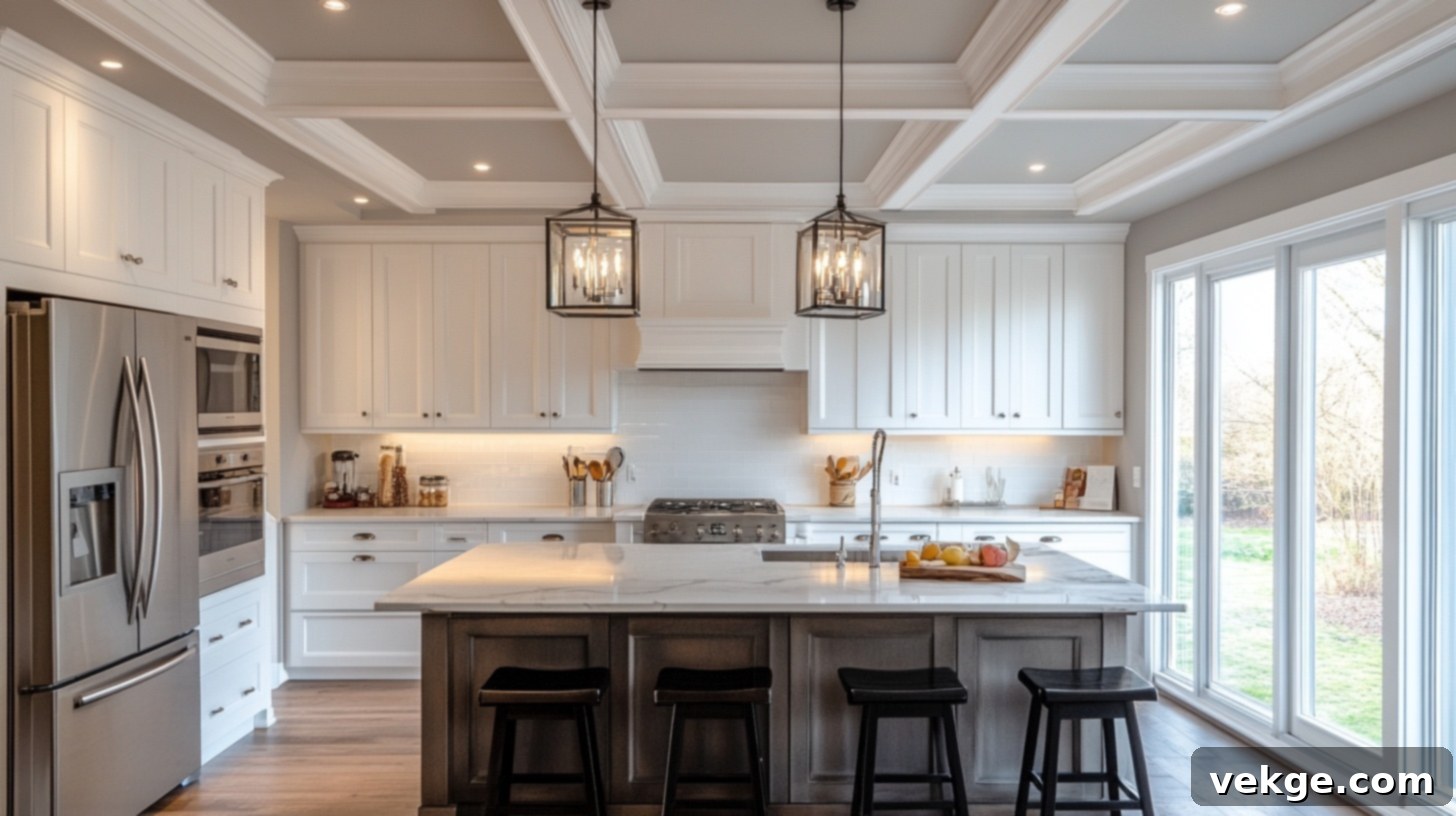Transform Your Kitchen Soffit: 16 Creative Ideas for Modern & Stylish Spaces
Do you have those awkward, boxy structures above your kitchen cabinets that feel out of place, making your kitchen look dated or cramped? You’re likely dealing with a kitchen soffit, and you’re not alone. Many homeowners wonder what to do with these often-overlooked architectural elements. If you’re seeking inspiration and practical solutions, you’ve landed in the perfect spot.
Kitchen soffits can indeed be a design challenge, making a space feel smaller or stuck in a past era. However, rather than seeing them as a hindrance, imagine them as a canvas for creativity. This comprehensive guide will arm you with innovative kitchen soffit ideas—from cleverly disguising them to transforming them into functional features, or even exploring the option of removal. I’ll share insights gained from real-world projects, covering everything you need to know to make an informed decision for your home.
We’ll delve into what might be hidden behind your soffit, the benefits and drawbacks of each renovation approach, and essential tips to avoid common mistakes. Get ready to discover a fix that perfectly aligns with your kitchen’s style and your personal preferences, turning that once-problematic soffit into a highlight of your culinary space.
What Exactly is a Kitchen Soffit?
A kitchen soffit is a structural element typically found above upper kitchen cabinets, spanning the gap between the top of the cabinets and the ceiling. Often constructed from drywall or wood, it’s usually painted to match the surrounding walls or cabinetry, aiming to blend seamlessly into the kitchen’s design. But these aren’t just decorative boxes; they serve several practical purposes that were once common in home building.
- Concealing Utilities: One of the primary functions of a soffit is to discreetly hide unsightly but essential utilities. Inside, you might find a maze of air vents for your HVAC system, electrical wiring for lighting or appliances, or plumbing pipes. Without the soffit, these necessary components would be exposed, creating a cluttered and unfinished appearance.
- Bridging the Gap: Many kitchens feature standard-height cabinets that don’t reach the ceiling. Soffits were historically used to fill this void, preventing dust and grime from accumulating on top of the cabinets and providing a cleaner, more integrated look, even if it limited vertical space.
- Cost-Effective Construction: From a builder’s perspective, incorporating soffits was often a more economical solution than installing custom-built, taller cabinets that extend all the way to the ceiling. It allowed for standardized cabinet sizes while still achieving a finished look without incurring the extra material and labor costs of custom cabinetry.
Common Drawbacks and Design Challenges with Kitchen Soffits
While soffits serve practical functions, they often come with aesthetic and functional drawbacks that can impact the overall feel of a kitchen:
- Cramped and Confined Feel: The boxy nature of soffits can visually lower the ceiling, making a kitchen feel more enclosed, less spacious, and even claustrophobic. This is particularly noticeable in smaller kitchens or those with lower ceilings, where every inch of vertical space is crucial.
- Outdated Appearance: Soffits are a hallmark of older kitchen designs. Modern kitchen aesthetics typically favor an open, airy feel, often achieved by extending cabinets to the ceiling or leaving an open space above for decorative elements. An existing soffit can instantly date a kitchen, making it feel less contemporary.
- Limited Storage Potential: Perhaps one of the biggest complaints about soffits is the wasted space they represent. If the soffit were removed, that area could often be utilized for taller cabinets, providing invaluable additional storage—a premium in any kitchen.
- Design Constraints: Soffits can limit design flexibility, making it challenging to install certain types of lighting, add decorative molding that extends to the ceiling, or create a truly seamless, floor-to-ceiling cabinet design.
16 Amazing Kitchen Soffit Ideas to Try
If your kitchen soffit feels like an outdated eyesore, it’s time to rethink its potential. Instead of being a design challenge, it can become an integral part of your kitchen’s aesthetic. Here are some creative and practical ideas to help you transform that space, ranging from simple cosmetic updates to more structural changes.
Disguising Soffits: Make Them Blend Seamlessly
The goal here is to make your soffit disappear into the background or at least appear less prominent, creating a more cohesive and less interrupted visual flow in your kitchen. These techniques focus on matching colors, textures, and architectural details to achieve a unified look.
1. Paint to Match the Wall Color
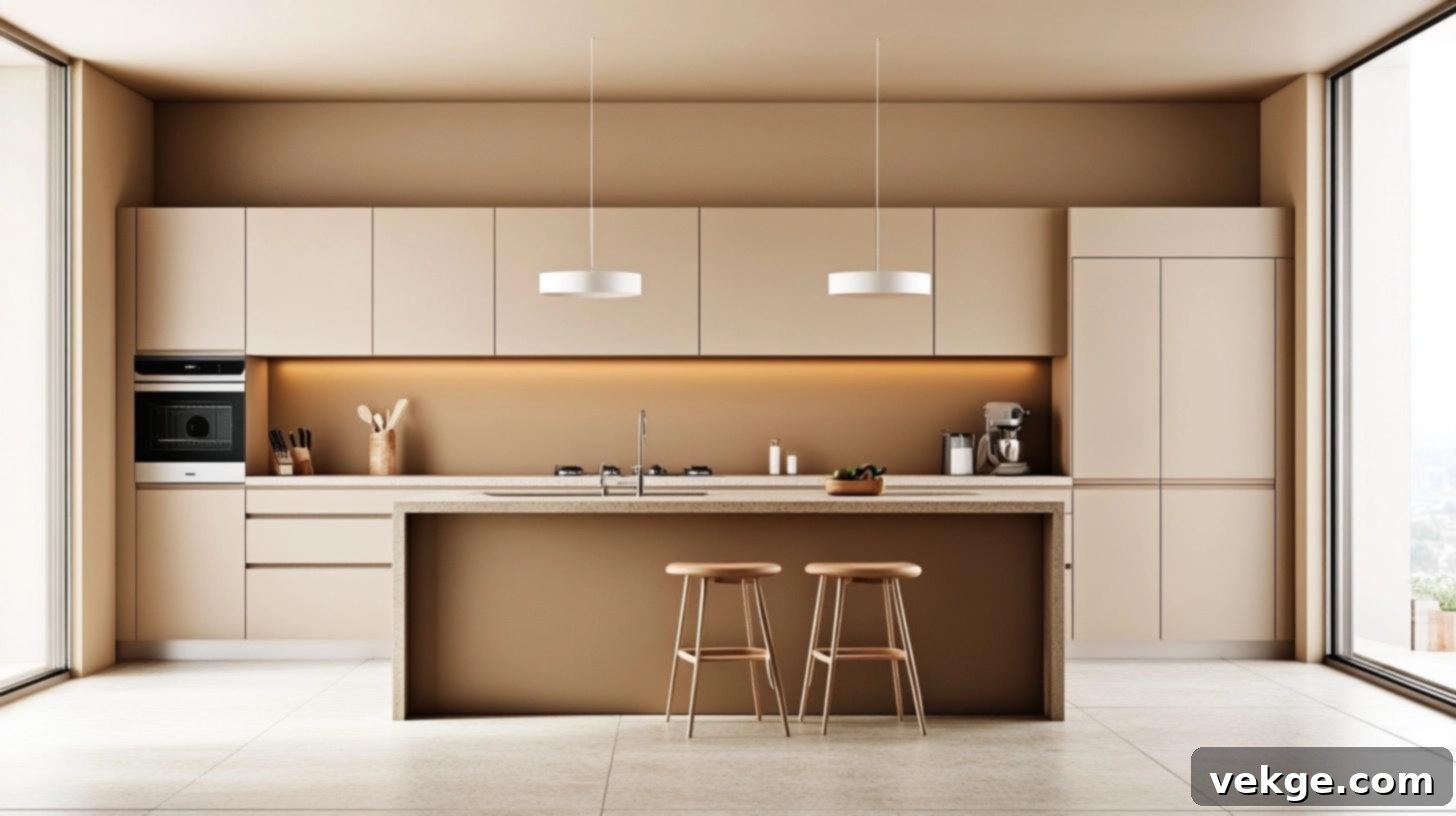
One of the simplest, most budget-friendly, and effective ways to make a soffit less noticeable is to paint it the exact same color as your surrounding walls. This visual trick helps the soffit blend into the background, allowing the eye to sweep across the space without interruption. By creating a continuous color field, the soffit becomes less of a distinct element and more of an integrated part of the wall, enhancing the perception of openness. For best results, choose a neutral shade that complements your kitchen’s overall palette, ensuring a calm and expansive feel. This method is incredibly versatile and works well in almost any kitchen style.
2. Incorporate Elegant Crown Molding
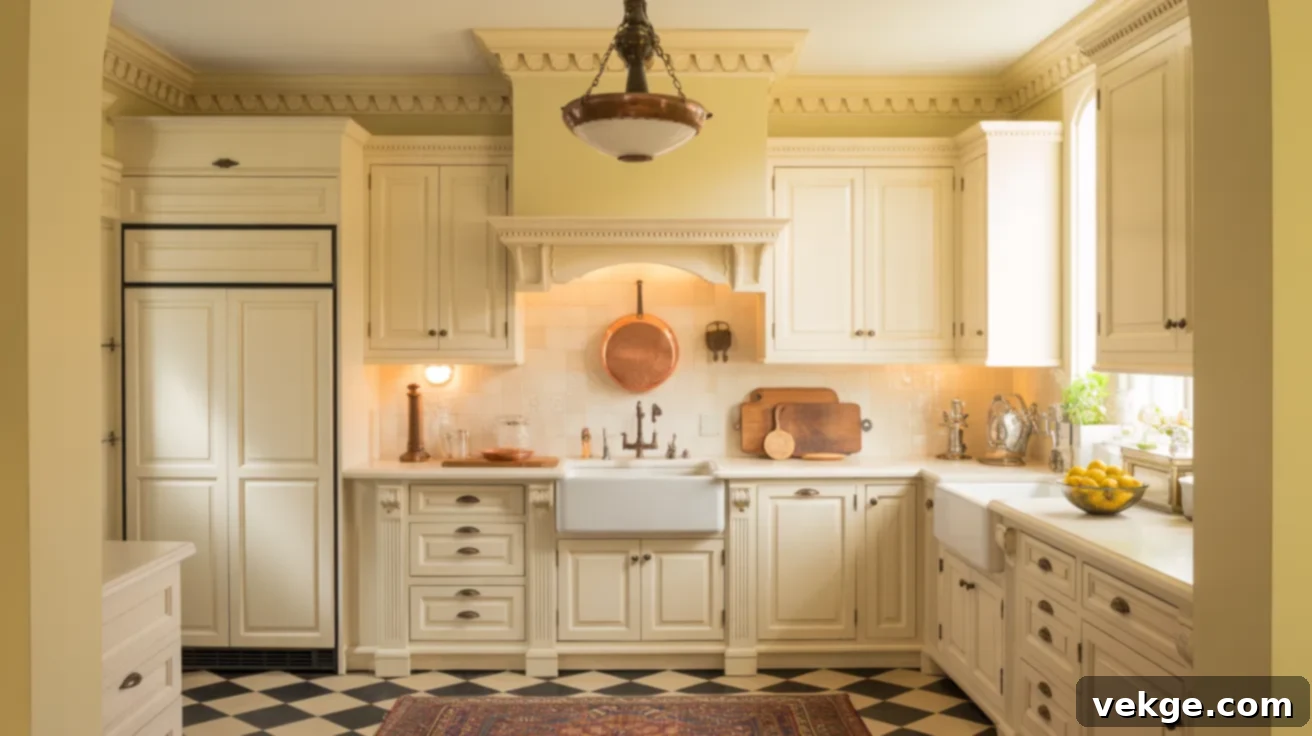
Adding crown molding to your soffit can instantly elevate its appearance, giving it a polished and custom-built look. Crown molding acts as a sophisticated transition between the soffit and the ceiling, making the soffit feel less like an afterthought and more like a deliberate design element. This approach is particularly effective in traditional, transitional, or formal kitchen settings, where decorative trim is a common feature. Even in modern spaces, simple, clean-lined crown molding can add architectural interest and a sense of completeness, helping to hide any imperfections where the soffit meets the ceiling and creating a visually balanced space.
3. Add Textured Beadboard or Shiplap Paneling
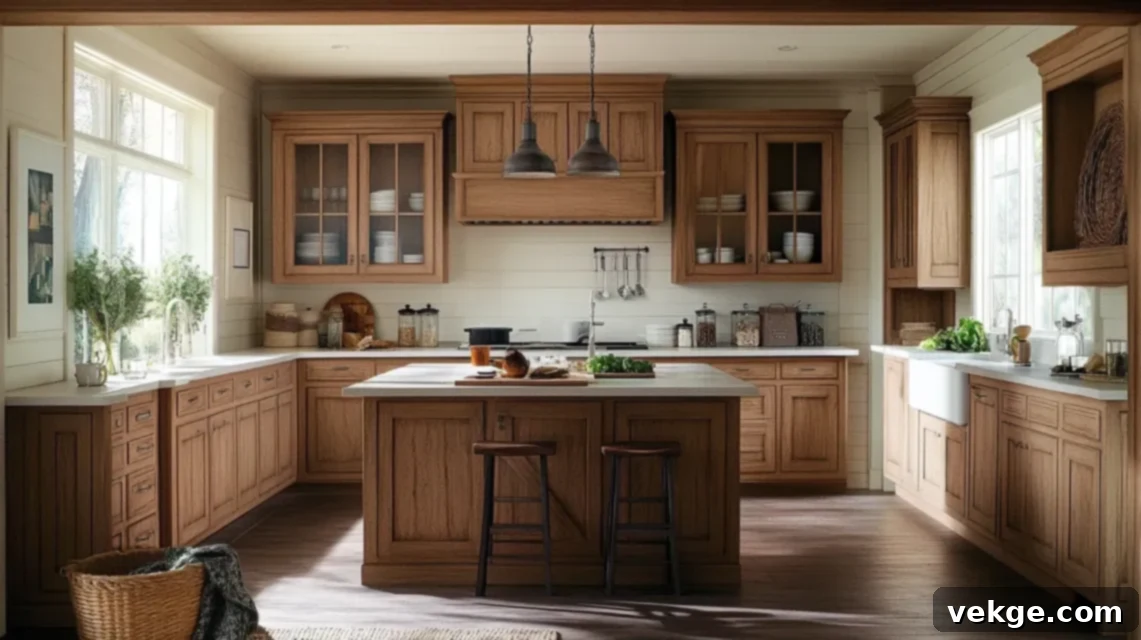
To inject character and texture, consider covering your soffit with beadboard or shiplap panels. These materials are renowned for their ability to bring a cozy, rustic, or coastal farmhouse charm to a space. When applied to a soffit, they transform a plain, flat surface into an appealing design feature. You can paint the panels a crisp white for a bright, airy feel, or choose a color that harmonizes with your cabinetry or walls. This method is excellent for adding a unique personality to an otherwise bland kitchen and can turn the soffit into a delightful focal point rather than something to conceal.
4. Match the Cabinet Color for Cohesion
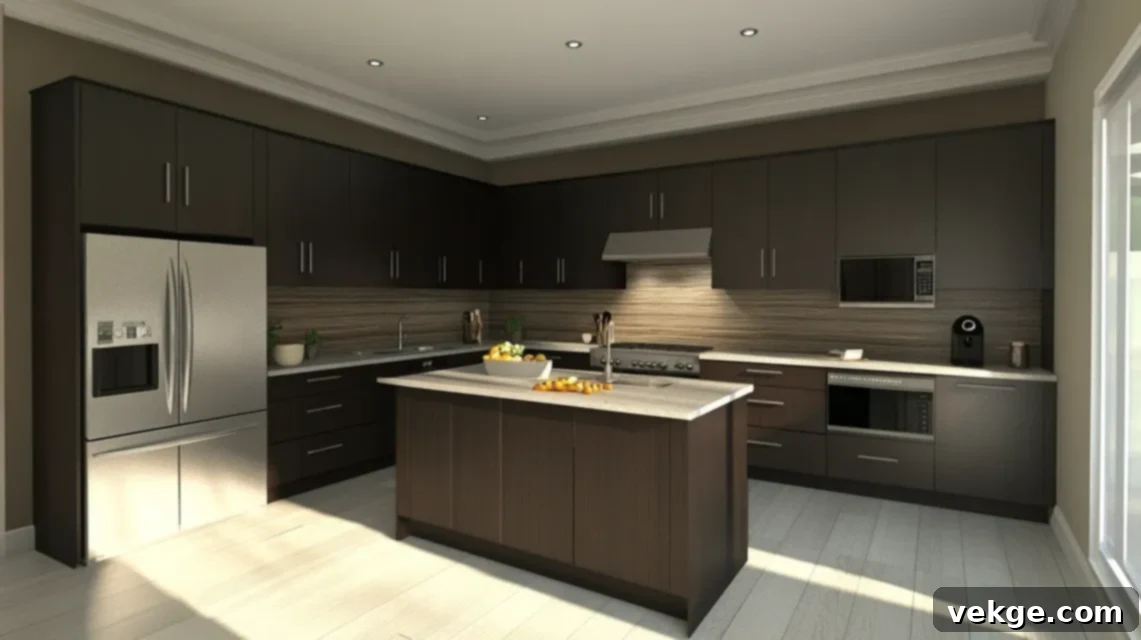
Painting your soffit the same color as your kitchen cabinets creates a powerful illusion of continuity and extends the cabinetry upwards, making your kitchen appear more unified and custom-designed. When the soffit visually merges with the cabinets, it no longer stands out as a separate, intrusive box. This strategy is particularly impactful in kitchens with taller upper cabinets or those featuring darker cabinet colors, as it adds depth and a sense of architectural grandeur. The result is a sleek, built-in appearance that instantly updates the space and eliminates visual clutter.
5. Extend Cabinets Upward with Faux Fronts
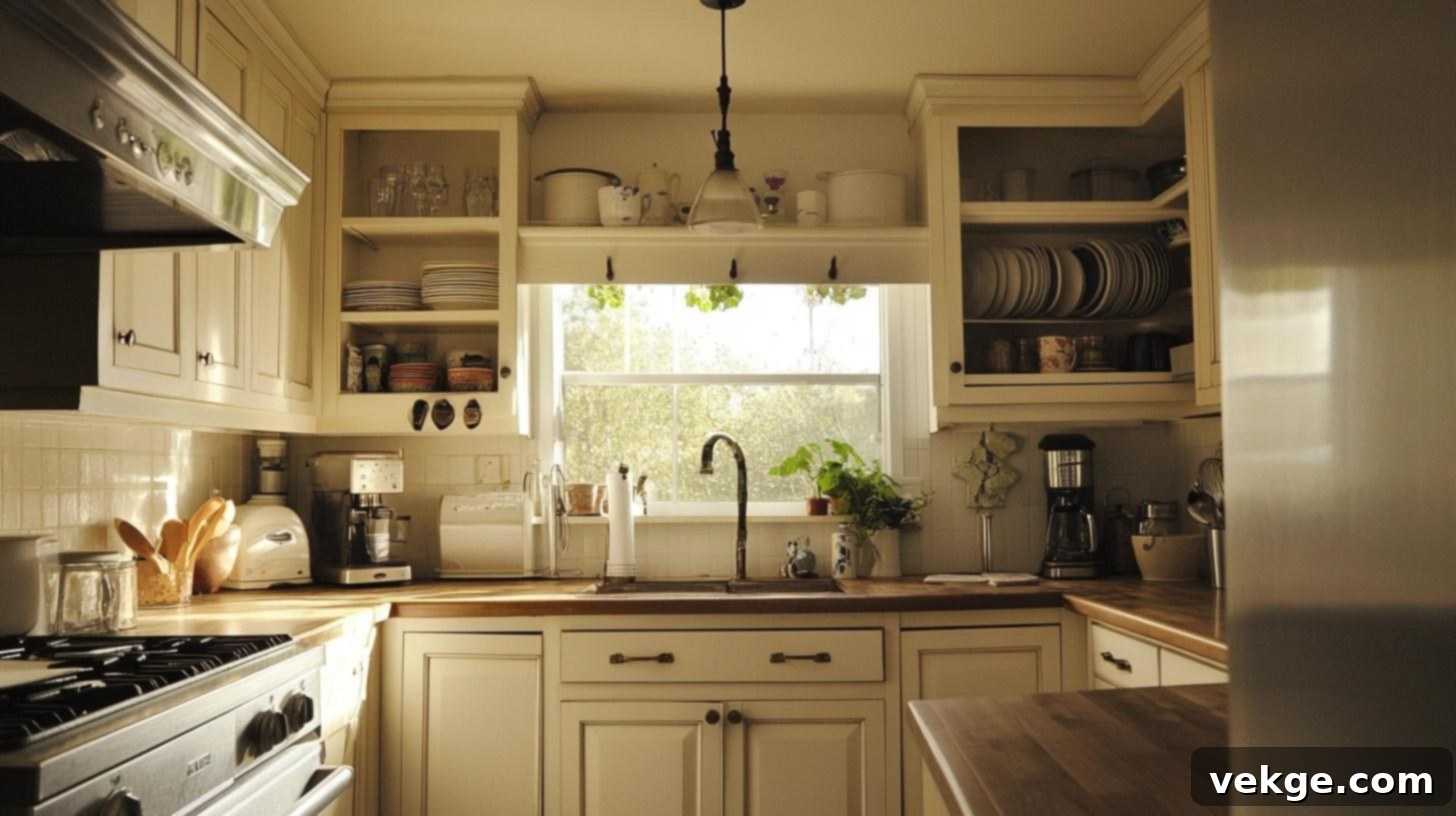
For a truly custom and high-end look, consider installing faux cabinet fronts directly onto the face of the soffit. These panels don’t need to be functional doors; their purpose is purely aesthetic, making it appear as though your cabinets extend all the way to the ceiling. This creates a seamless, built-in appearance that can dramatically transform an ordinary kitchen into something extraordinary. This trick is especially valuable in older homes where soffits are common, as it allows you to create a modern, integrated look that ties the entire kitchen together, making it feel more expansive and thoughtfully designed.
6. Install Removable Wallpaper or Decals
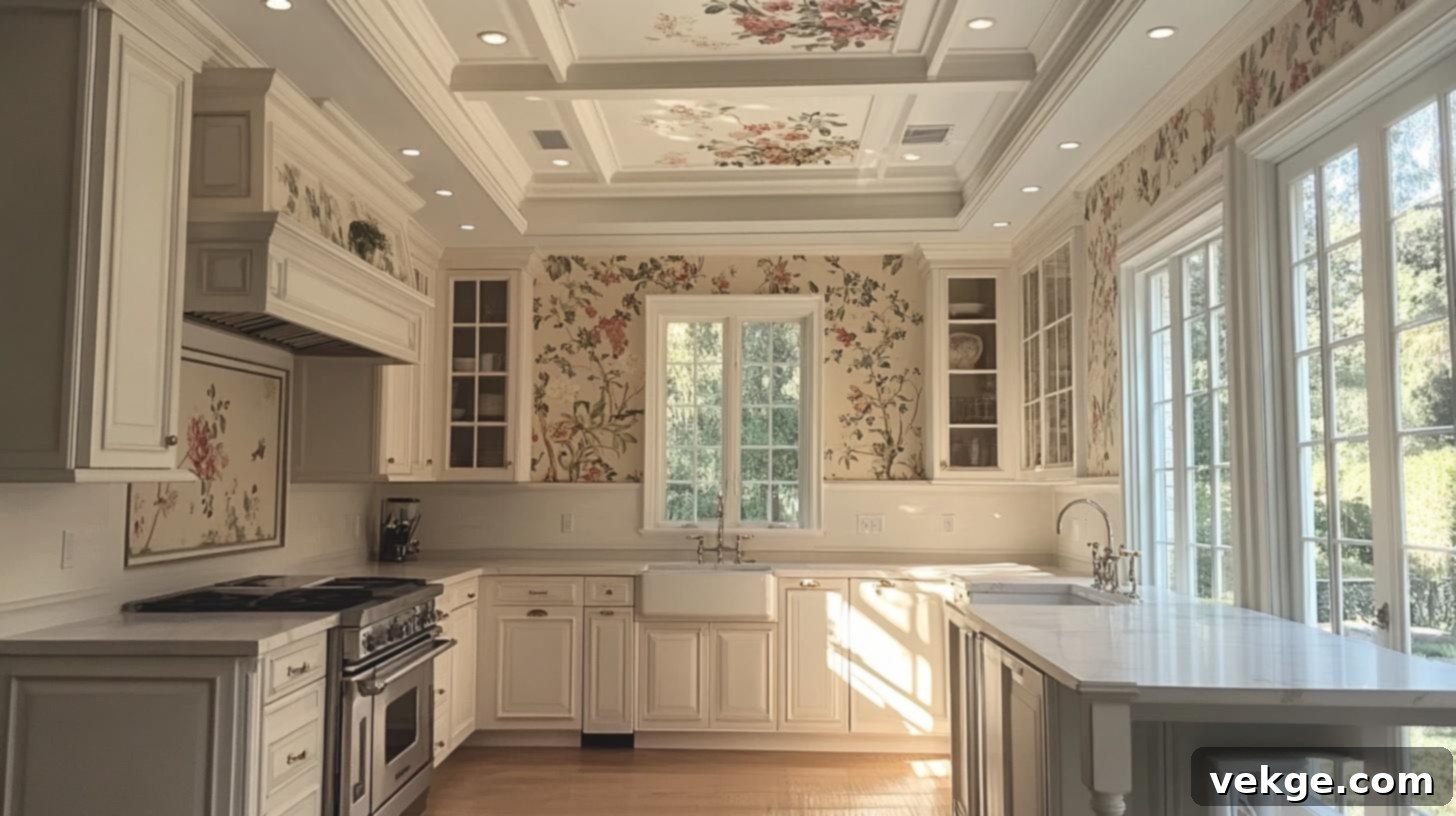
Inject personality and vibrant design into your kitchen by applying peel-and-stick wallpaper or decorative decals to your soffit. This is an excellent solution for renters or anyone who loves to change their decor frequently, as it’s easily removable and replaceable. Choose patterns, textures, or colors that complement your kitchen’s existing style—whether it’s a playful floral, a sophisticated geometric, or subtle stripes. This method offers a fun, creative, and low-commitment way to transform a dull soffit into an eye-catching feature that adds interest and charm without breaking the bank.
7. Attach Faux Cabinet Doors for Hidden Storage Illusion
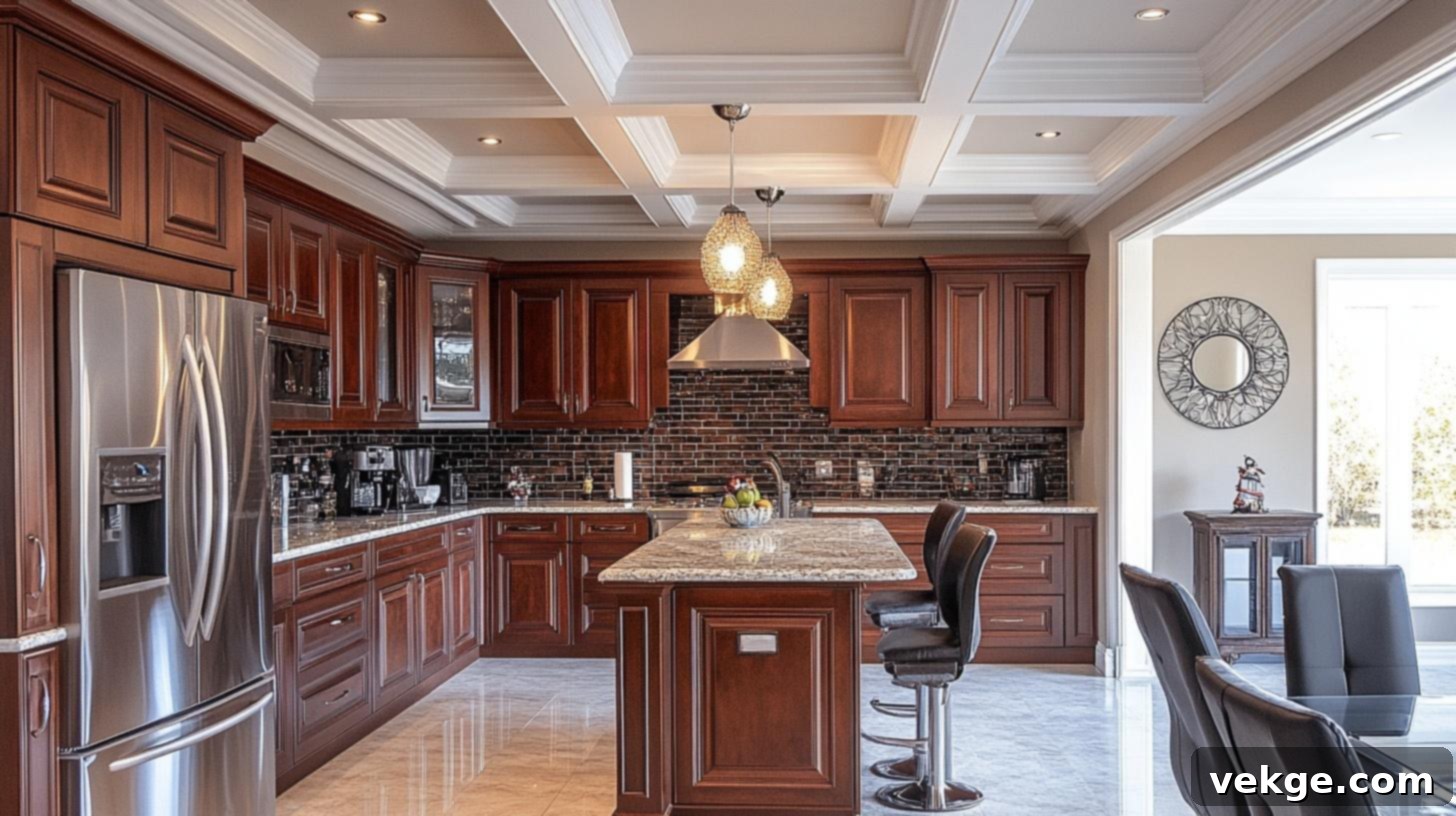
Similar to extending cabinets upwards, adding actual faux cabinet doors or custom trim pieces to the face of your soffit creates the convincing illusion of hidden upper storage. While these doors won’t open to reveal shelves, they will visually integrate the soffit seamlessly with your existing cabinetry. Select door styles and hardware that perfectly match your current cabinets for an unbroken line of sight. This idea works wonderfully in traditional kitchens or for anyone aiming to make their soffit blend in so effectively that it simply disappears as an independent element, contributing to a more cohesive and expensive look.
Decorating Soffits: Turn Them into Stylish Features
Instead of hiding your soffit, why not embrace it and turn it into a deliberate focal point? These ideas transform the soffit into a space for display, lighting, or unique personal touches, celebrating its presence rather than trying to diminish it.
8. Display Art or Vintage Signs
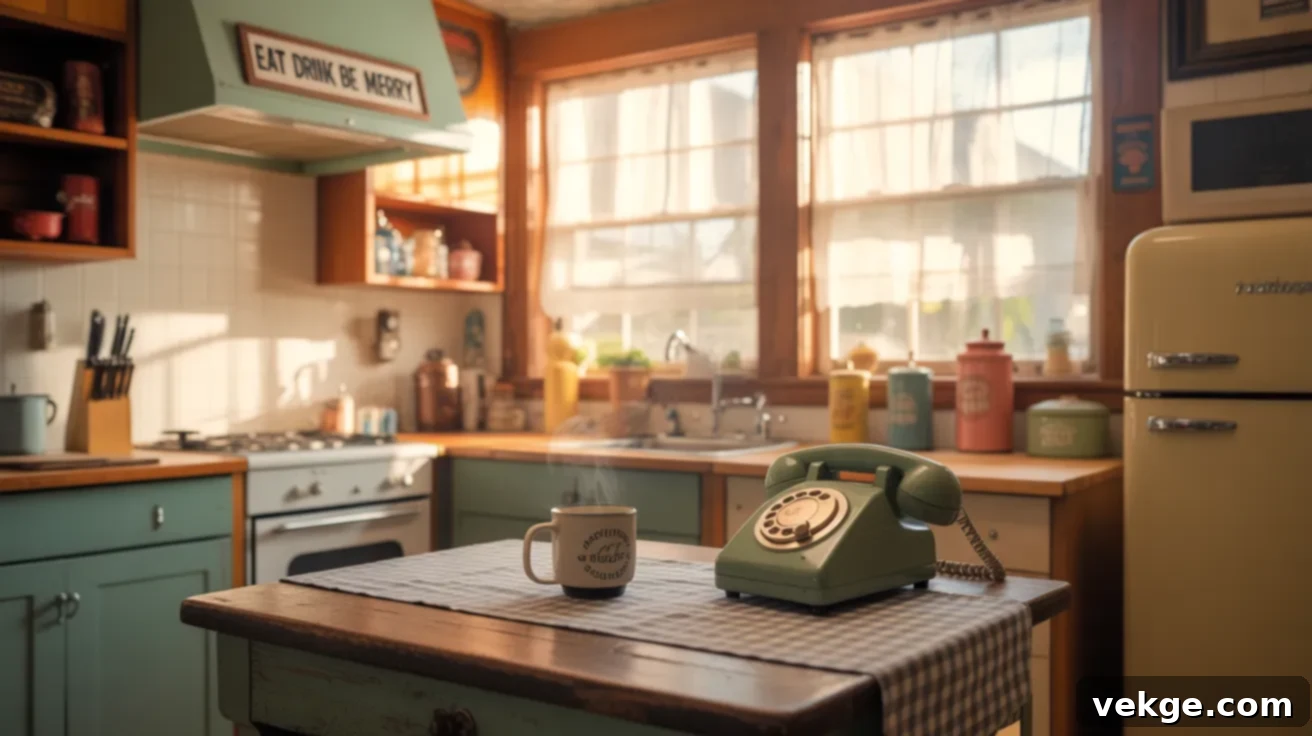
Give your kitchen a personalized touch by using the soffit as a mini gallery for small artwork, framed prints, or vintage kitchen-themed signs. Choose lightweight pieces that can be easily hung without causing structural damage to the soffit. Think framed recipe cards, whimsical food-related quotes, antique metal advertisements, or small abstract paintings that echo your kitchen’s color scheme. This not only adds personality and warmth but also draws the eye upwards, transforming an otherwise forgotten space into an intentional decorative element. It’s particularly effective if your soffit is at or slightly above eye level, making the display easily viewable and appreciated.
9. Add Potted Plants or Trailing Greenery
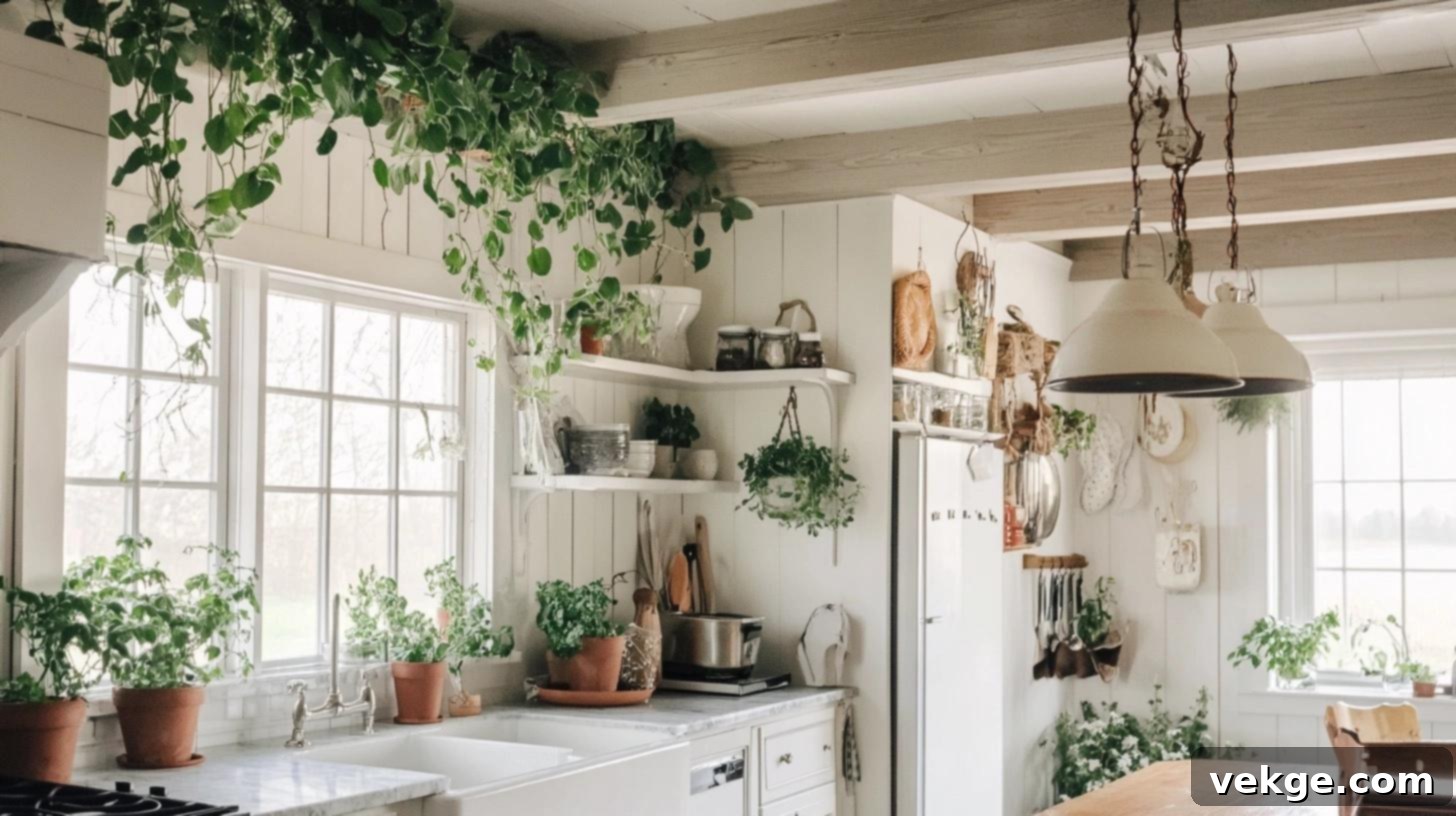
If your soffit has a flat, accessible top, it presents a perfect opportunity to introduce natural elements into your kitchen. Small potted plants, such as succulents, air plants, or trailing vines, can add a vibrant touch of life and freshness. Consider placing small herb planters if there’s adequate light, or opt for high-quality faux greenery if natural light is scarce or maintenance is a concern. The addition of plants brings color, organic texture, and a sense of calm to the kitchen environment. You could also hang small herb baskets or macramé plant hangers nearby to further enhance this natural theme.
10. Use Subtle LED Strip Lighting
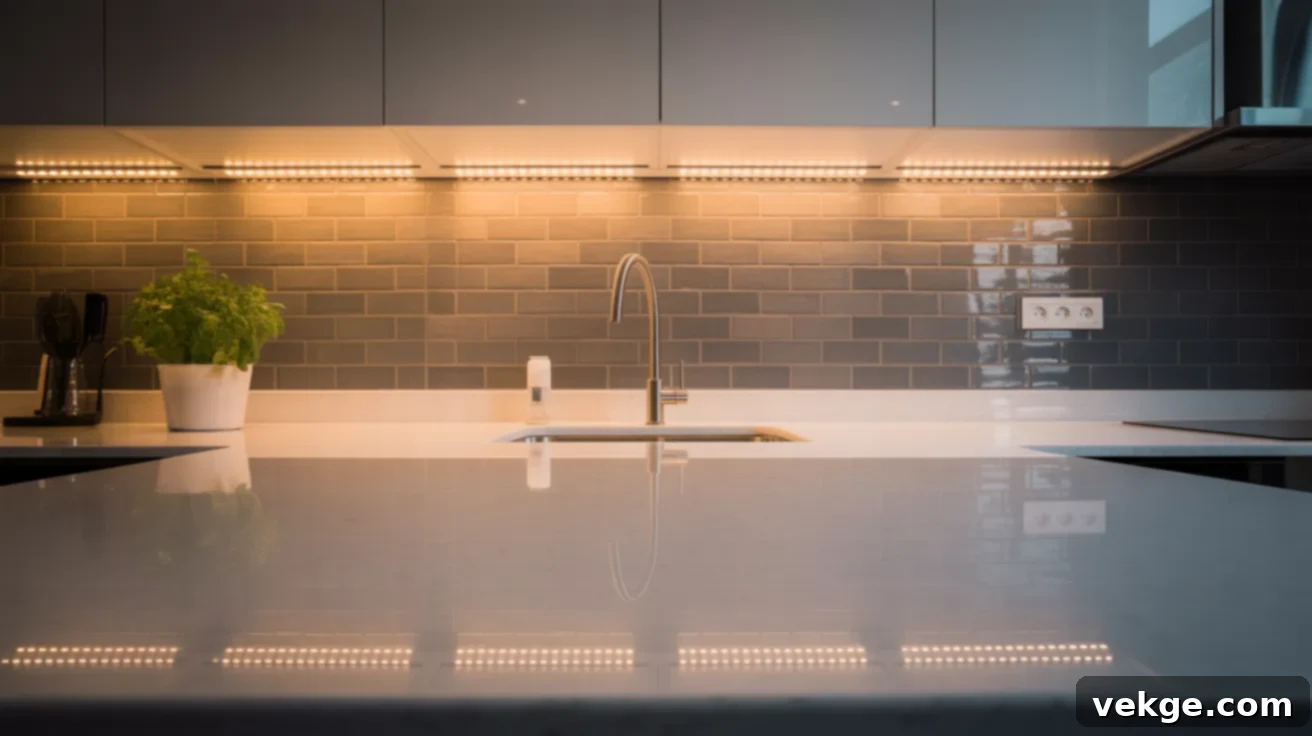
Illuminate your kitchen with sophisticated LED strip lighting installed along the underside of the soffit. This creates a soft, ambient glow that not only highlights your countertops but also adds a modern and inviting atmosphere to the entire space. LED strips are incredibly versatile, easy to install, and come in various color temperatures (from warm white to cool daylight), some even offering color-changing capabilities controlled by a remote or smart home system. This functional and stylish addition is perfect for contemporary kitchens or anyone looking to enhance mood lighting, improve task lighting for cooking, or simply add an element of subtle drama to their design.
11. Create Engaging Seasonal Displays
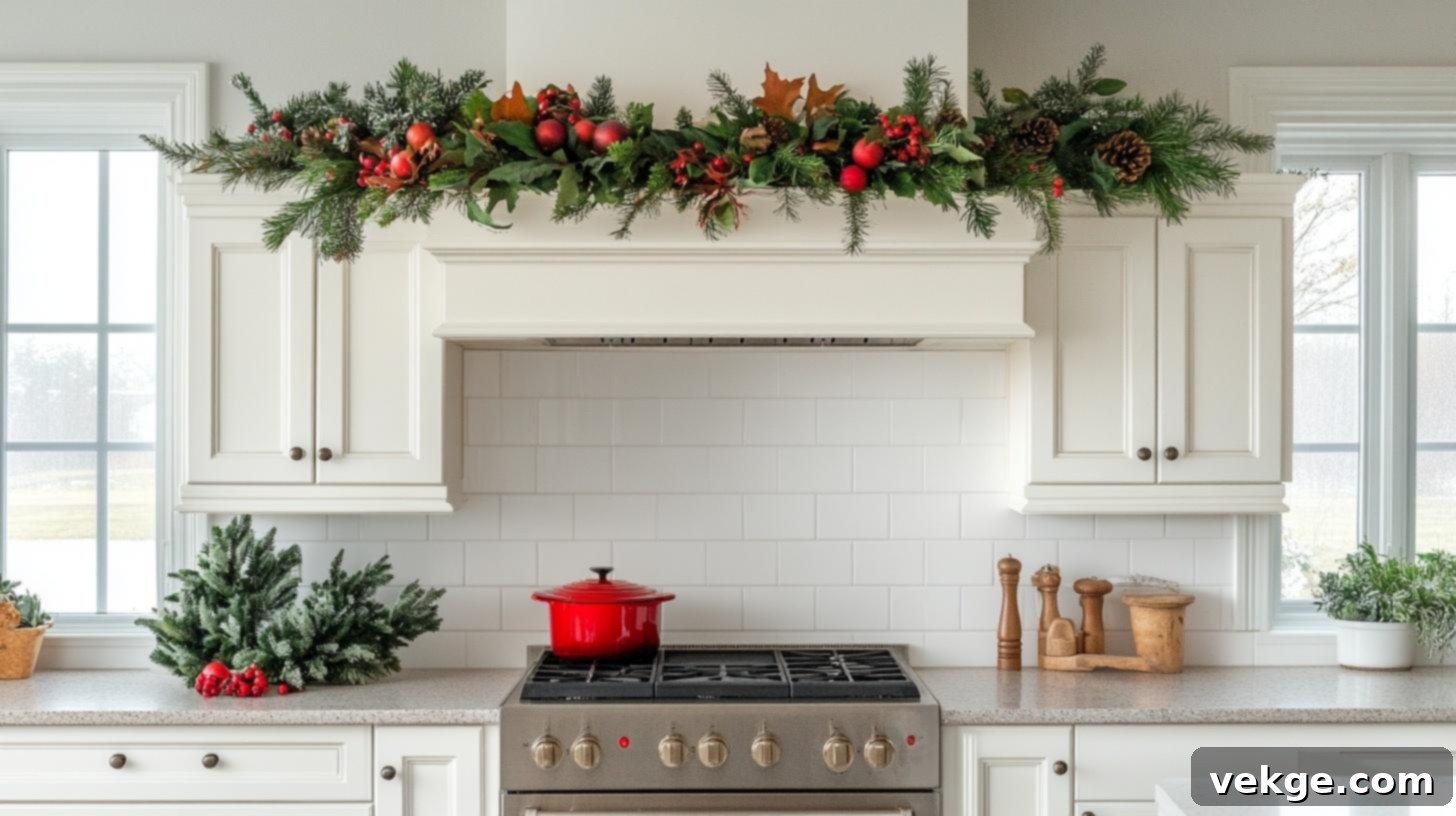
Leverage your soffit as a dynamic display area for seasonal decorations, keeping your kitchen feeling fresh and festive throughout the year. In autumn, arrange miniature pumpkins, colorful leaves, or a rustic garland. During the winter holidays, drape string lights, hang delicate snowflakes, or set up small festive figurines. Spring can be celebrated with faux flowers, pastel accents, or charming bird figurines, while summer might feature bright lemons, coastal elements, or vibrant fruit displays. The beauty of this idea is its flexibility; you can rotate themes with ease, preventing your kitchen from feeling stale and adding a touch of personality without cluttering valuable counter space.
12. Curate a Personal Gallery Wall
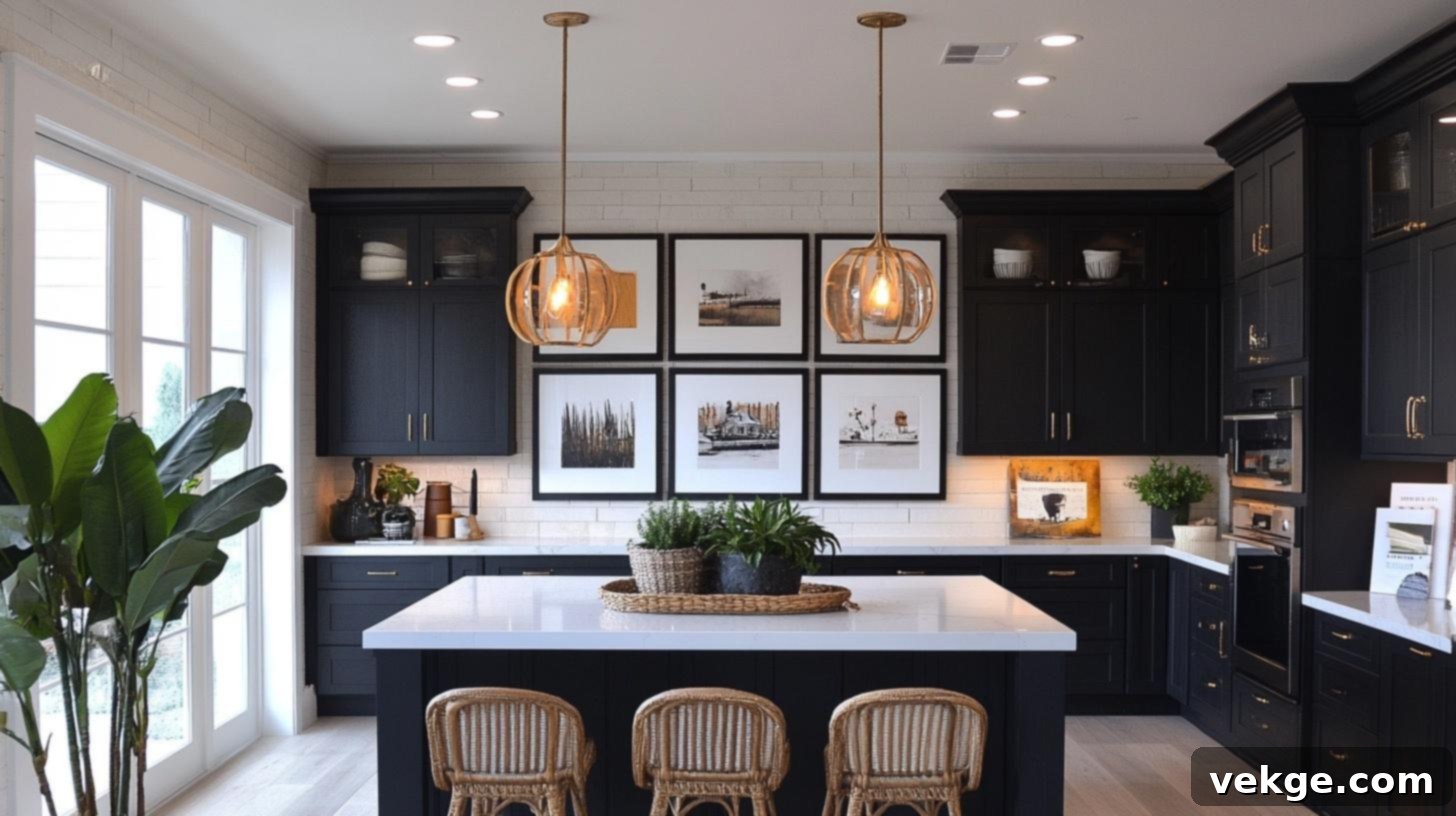
Transform your soffit into a cherished gallery space by showcasing a collection of personal items, such as family photographs, children’s artwork, or framed sentimental recipes. This approach turns the soffit into a truly meaningful focal point, telling a story and reflecting your family’s history and memories. Keep frames relatively small and lightweight to avoid overburdening the structure. You can experiment with different frame styles and arrangements to create a visually interesting collage. Periodically swapping out items allows you to update the display with new memories or fresh artwork, keeping the kitchen feeling vibrant and personal.
13. Design a Functional Message Board
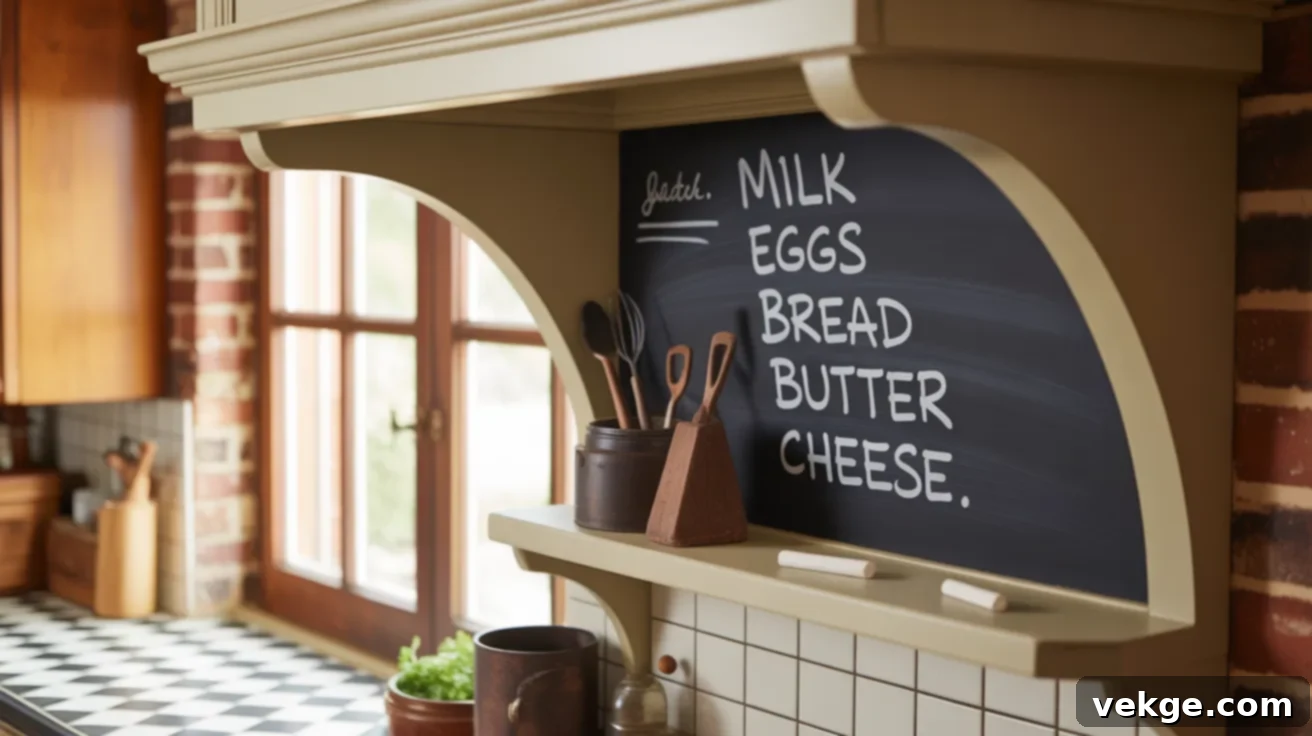
For busy households, turning the soffit into a practical message board can be an ingenious solution. Paint the soffit with chalkboard paint for a rustic, interactive surface or whiteboard paint for a sleek, modern look. This allows you to jot down grocery lists, leave daily reminders, share family schedules, or even doodle right on the surface. To enhance its utility, consider installing a small, narrow ledge underneath to hold chalk, markers, and an eraser. This idea seamlessly blends functionality with creativity, transforming an otherwise ignored soffit into an active and integral part of your daily kitchen routine.
14. Add a Decorative Tile Feature
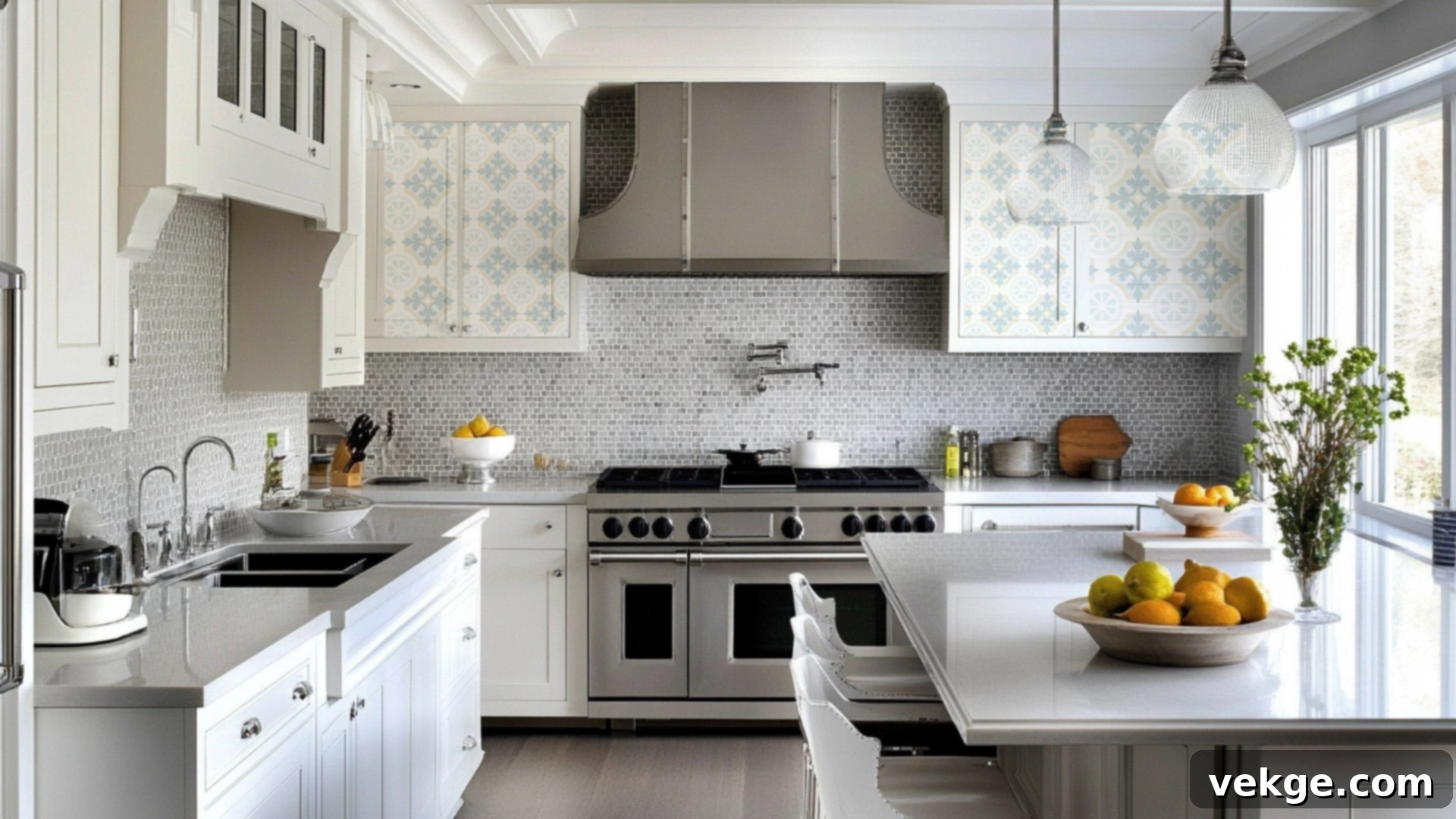
Extend the visual appeal of your backsplash or introduce a new design element by applying tile to the face of your soffit. This can create a striking and unexpected focal point that adds texture, color, and depth to your kitchen. You can opt for simple, classic subway tiles for a clean look, or choose intricate mosaic tiles for a burst of pattern and detail. Depending on your kitchen’s style, you might go for neutral shades that blend in or bold colors that make a statement. Peel-and-stick tiles offer a less permanent and easier installation option. This idea works particularly well in kitchens that already feature tiled backsplashes or have a modern, detail-oriented design.
Repurposing or Building Around Soffits: Smart Functional Solutions
When removing a soffit isn’t an option, clever repurposing strategies can transform it into a functional and stylish asset. These ideas focus on adding utility and aesthetic value through structural additions or clever design integrations.
15. Build Additional Open Shelves
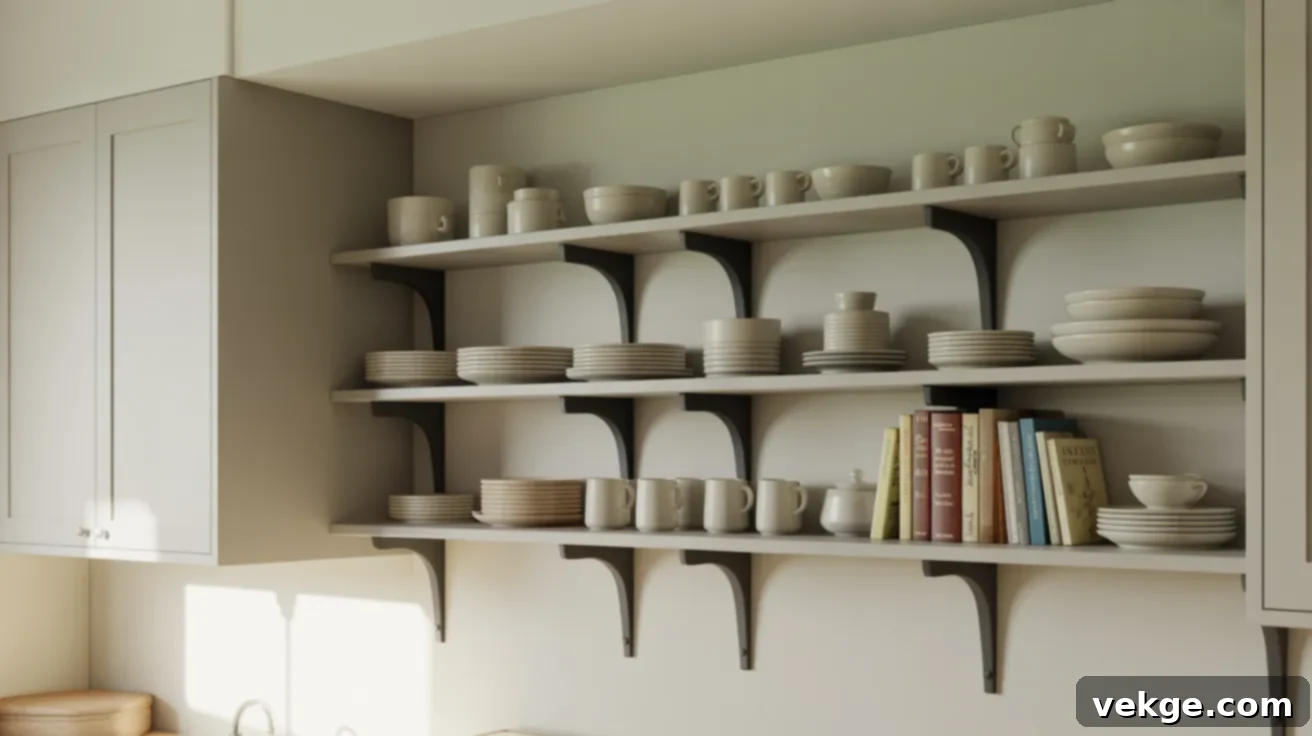
If there’s usable space directly below your soffit and above your existing cabinets, consider installing a row of open shelves. These shelves are incredibly versatile and can be used to store and display frequently used dishes, attractive mugs, a collection of cookbooks, or decorative kitchenware. Open shelving not only maximizes vertical space, providing much-needed additional storage, but also helps to fill awkward gaps, making the kitchen feel more thoughtfully designed and put-together. Choose materials like reclaimed wood, sleek metal, or painted lumber that complement your kitchen’s aesthetic for a cohesive look without the need for a major renovation.
16. Turn It into a Decorative Beam-Style Divider
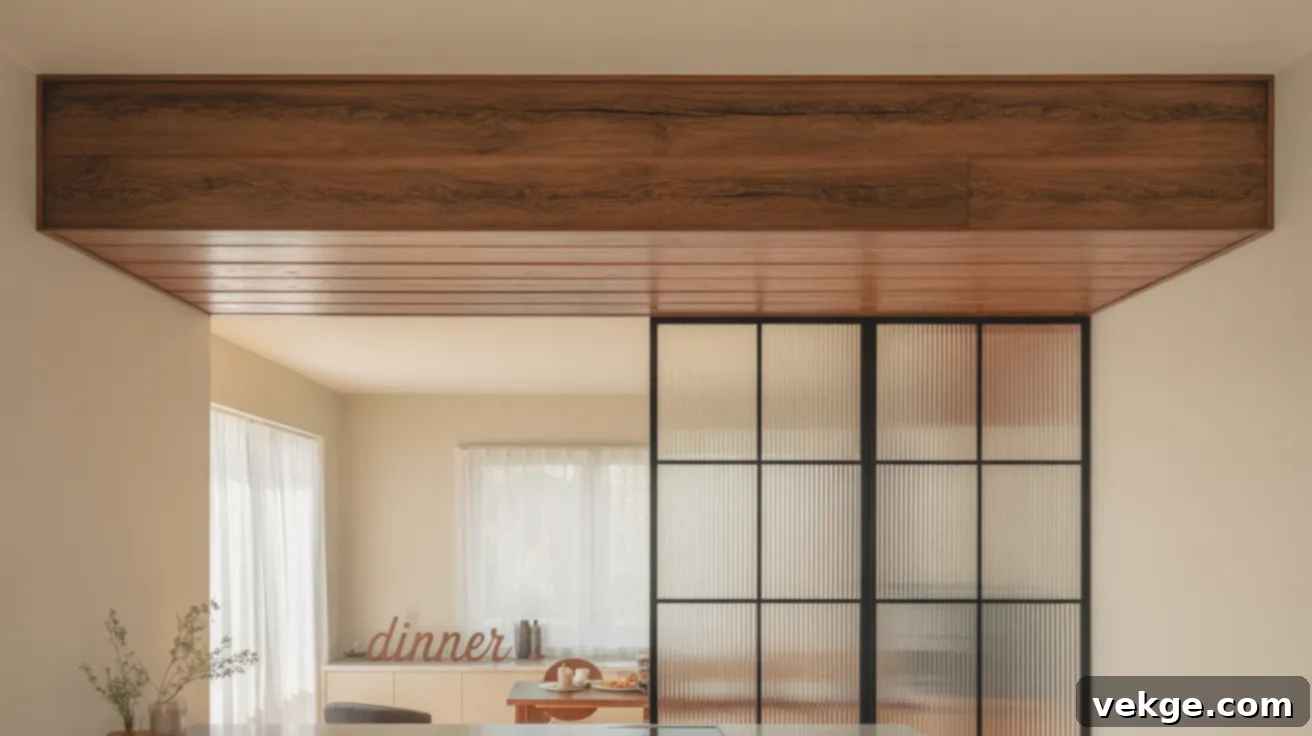
In kitchens with an open-concept layout where the soffit naturally divides two spaces, you can transform it into an architectural feature by wrapping it in wood or wood-look panels. This creative approach makes the soffit resemble an exposed ceiling beam, adding warmth, character, and a sense of purpose to the structure. You can stain the wood to match other timber elements in your home, creating a harmonious and rustic or modern industrial feel. This smart design move turns a potentially intrusive soffit into a deliberate and attractive architectural element that helps to define distinct zones within an open-plan kitchen, making it feel less like a mistake and more like a deliberate design choice.
Should You Remove Your Kitchen Soffit? Weighing the Options
Deciding to remove a kitchen soffit is a significant renovation step that can dramatically alter the perception and functionality of your space. However, it’s not a decision to be taken lightly, as it can uncover hidden challenges. Here’s a balanced look at the pros and cons to help you determine if soffit removal is the right path for your kitchen and budget.
| Pros of Soffit Removal | Cons of Soffit Removal |
|---|---|
| Enhanced Space and Openness | Potential for Hidden Surprises |
| Removing the soffit instantly creates more vertical space, making your kitchen feel significantly larger, airier, and more open. This allows for taller cabinets, more dramatic lighting fixtures, or simply an uncluttered wall area that draws the eye upward. | The biggest unknown. Soffits often conceal critical utilities such as HVAC ductwork, electrical wiring, plumbing pipes, or even structural elements. Discovering these requires rerouting, which can be complex, costly, and time-consuming. |
| Modernized Aesthetic | Higher Costs and Unforeseen Expenses |
| Eliminating a soffit often updates your kitchen’s look, giving it a more contemporary, sleek, and minimalist appeal. It removes an architectural element that can often scream “dated,” bringing your kitchen in line with current design trends. | Beyond the labor of removal, you’ll likely face costs for rerouting utilities, repairing and patching walls and ceilings, painting, and potentially installing new, taller cabinets or decorative trim to fill the newly opened space. Unexpected issues can quickly escalate the budget. |
| Increased Storage Potential | Disruptive and Messy Project |
| The newly liberated space above your cabinets can be utilized for installing taller, ceiling-height cabinets, providing a substantial increase in storage capacity. This is invaluable in any kitchen, especially smaller ones. Alternatively, it allows for open shelving or decorative displays. | Soffit removal is inherently a demolition project. Expect significant dust, debris, noise, and disruption to your daily life. The process can be time-consuming, and if you’re living in the home during the renovation, it can be quite challenging. |
| Improved Lighting Opportunities | Impact on Structural Integrity (Rare but Possible) |
| Removing the soffit opens up the ceiling plane, offering greater flexibility for installing recessed lighting, stylish pendant lights, or even larger windows if the soffit was part of a window casing, enhancing overall brightness and ambiance. | While less common, some soffits might be part of the home’s structural framing. Removing a load-bearing element without proper support can compromise the integrity of your home, requiring professional assessment and potentially costly structural modifications. |
Before you even think about swinging a hammer, it is absolutely crucial to investigate what lies within your soffit. Many soffits are far from empty. They frequently hide:
- Electrical Wiring: For overhead lights, outlets, or even entire circuits.
- Plumbing Pipes: Vent stacks, water lines to upper floors, or drainage pipes.
- Air Vents or Ductwork: Essential for HVAC systems, moving air to and from different rooms.
- Structural Beams or Framing: Sometimes, soffits are built around or conceal a necessary part of the house’s framing.
- Old Lighting Fixtures: Or the wiring for them.
You cannot determine the contents just by a superficial glance. In nearly all cases, you’ll need a qualified professional—such as a contractor, electrician, or plumber—to carefully inspect the soffit. This might involve cutting small exploratory holes. If important systems are discovered, you’ll face the added complexity and expense of moving or rerouting them, which significantly impacts your project timeline and budget.
DIY vs. Professional Kitchen Soffit Removal: Making the Right Call
The decision to tackle soffit removal yourself or hire a professional largely hinges on what’s inside the soffit and your comfort level with home renovation projects. A seemingly simple drywall box can quickly become a complex undertaking.
If a preliminary inspection (or confident knowledge about your home’s construction) suggests the soffit is likely empty or only contains non-critical elements (like old, defunct wiring), and you possess a good set of tools and DIY experience, then a DIY removal might be a feasible weekend project. You’ll need to meticulously ensure all power and water are turned off in the area, carefully cut into the drywall, and be prepared for dust, debris, and potential minor surprises. Safety precautions, like wearing protective gear, are paramount.
However, if there’s any uncertainty about the contents, or if the inspection reveals live electrical wiring, active plumbing, HVAC ductwork, or structural components, then hiring a professional is not just recommended, it’s essential. A licensed contractor, electrician, or plumber has the expertise to safely identify and handle these elements, ensuring compliance with building codes and preventing costly damage or safety hazards. They can manage the rerouting of utilities, execute the demolition efficiently, and expertly repair and finish the ceiling and walls once the soffit is gone. While professional help incurs a higher upfront cost, it’s often the safer, quicker, and ultimately less stressful choice for a smooth, high-quality result, especially when dealing with unforeseen complications.
Common Mistakes to Avoid When Dealing with Kitchen Soffits
Embarking on any home improvement project, especially one involving structural or semi-structural elements like a kitchen soffit, comes with potential pitfalls. Being aware of these common mistakes can save you significant time, money, and headaches during your renovation journey.
- Skipping the Essential Inspection: This is arguably the most critical mistake. Never, under any circumstances, begin demolition on a soffit without first thoroughly investigating its contents. What appears to be an empty drywall box could be concealing crucial electrical conduits, active plumbing pipes, or vital HVAC ductwork. Cutting into these without proper knowledge and precautions can lead to expensive repairs, water damage, power outages, or even safety hazards. Always get a professional assessment first.
- Neglecting to Measure for New Cabinets: If your plan involves removing the soffit to install taller cabinets, ensure you precisely measure the available space. Factor in the new cabinet dimensions, potential crown molding, and any ceiling imperfections. Ordering cabinets that don’t fit perfectly after demolition will lead to costly reorders, design compromises, or awkward gaps that defeat the purpose of the renovation.
- Ignoring Local Building Codes and Permits: Depending on what the soffit contains or if it’s considered a structural element, its removal or modification might be subject to local building codes and require permits. Ignoring these regulations can lead to fines, forced reconstruction, or issues when you try to sell your home. Always check with your local planning department before starting significant demolition work.
- Rushing the Demolition Process: Tearing into a soffit too aggressively or without care can cause unnecessary damage to surrounding walls, ceilings, and existing cabinets. This not only adds to the repair work and cost but can also create uneven surfaces that are difficult to patch smoothly. Take your time, use appropriate tools, and work meticulously to minimize collateral damage.
- Underestimating the Scope of Cleanup and Finishing: Soffit removal is inherently a dusty and messy job. Even if the soffit is small, expect drywall dust to permeate everything. Beyond the initial demolition cleanup, there will be patching, sanding, priming, and painting of the ceiling and walls to ensure a smooth, finished look. Underestimating the time and effort required for these finishing touches can lead to a less-than-satisfactory result and prolonged disruption.
- Failing to Consider Lighting Implications: Removing a soffit might leave a void where old lighting fixtures were installed or disrupt wiring for existing ceiling lights. Plan for new lighting solutions, whether it’s recessed lights, pendant fixtures, or track lighting, and ensure the electrical work is safely updated to accommodate these changes.
Final Thoughts on Enhancing Your Kitchen Soffit
As we’ve explored the diverse range of solutions for kitchen soffits, it’s clear that these architectural elements don’t have to be a source of frustration or an unsightly relic of past designs. From cleverly disguising them to transforming them into vibrant focal points or even considering their removal, you now have a wealth of ideas to reimagine this space. The right approach can turn that once-awkward overhead box into a truly useful, stylish, or both, extension of your culinary haven.
Whether your vision involves seamlessly integrating the soffit with extended cabinetry, adorning it with decorative trim, personal artwork, or modern lighting, or completely removing it to open up your kitchen, this comprehensive guide has provided you with the insights and inspiration needed to make the best decision for your home. Remember, no single solution fits every kitchen; the ideal choice depends on your specific layout, the hidden contents of your soffit, your personal style, and your budget.
There’s no need to rush into a decision. Take your time to carefully assess what’s behind your soffit, weigh the pros and cons of each option, and plan meticulously based on your space and financial considerations. Even a small, thoughtful update can yield a dramatic improvement in how your kitchen looks and feels.
I encourage you to embrace the challenge and unleash your creativity. Choose one of these kitchen soffit ideas and embark on a transformation that will not only enhance your kitchen’s aesthetic but also elevate your everyday living experience. Your dream kitchen, free from awkward soffit woes, is within reach.
